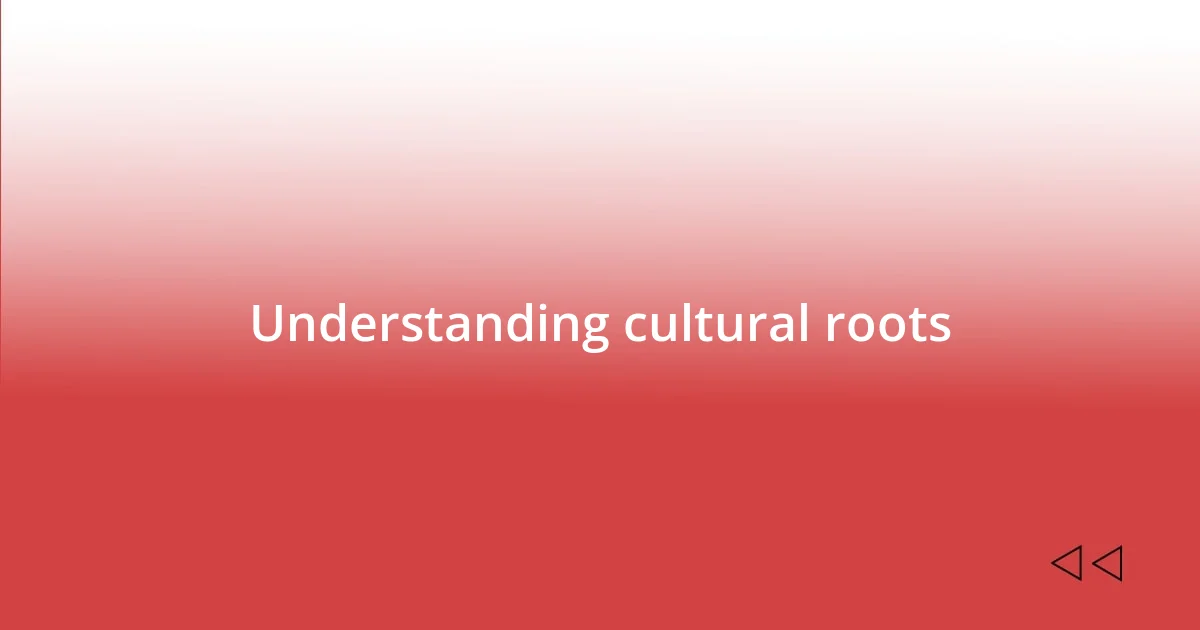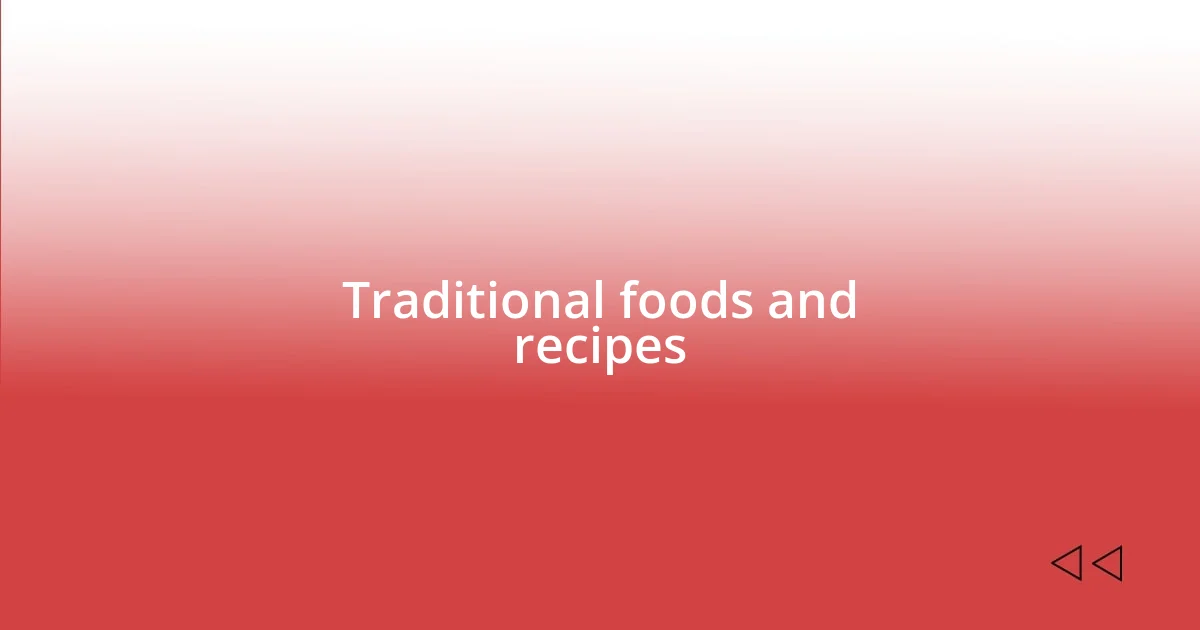Key takeaways:
- Understanding cultural roots enhances personal identity through immersive experiences, storytelling, and family traditions.
- Engagement in cultural festivals and community events fosters connections and strengthens communal ties while celebrating heritage.
- Sharing and preserving culinary traditions, arts, and personal narratives enrich relationships and highlight the significance of ancestry.

Understanding cultural roots
Understanding cultural roots involves delving into the rich tapestry of traditions, beliefs, and practices that shape our identities. For me, exploring my cultural roots often feels like piecing together a beautiful mosaic of family stories and heritage. Have you ever sat down with a grandparent during a family gathering, only to be swept away by tales of their youth? It’s in those moments that we realize how deeply our roots run and how they influence our lives today.
I still remember the first time I participated in a traditional festival celebrated by my community. The air was filled with the sweet scent of incense and the vibrant colors of traditional clothing—it was mesmerizing. In experiencing that celebration, I wasn’t just observing; I was actively connecting to my past and feeling the warmth of our shared identity. How often do we take the time to immerse ourselves in these cultural experiences rather than merely admiring them from afar?
Every small practice, from the food we eat to the songs we sing, offers a gateway into understanding who we are at our core. I often reflect on how my mother’s cooking incorporates spices and techniques passed down for generations. Have you thought about how your favorite family recipes carry stories of your ancestry? It’s fascinating to see how the ways we celebrate, remember, and honor our roots help us connect with our ancestors while also shaping our own unique narratives.

Identifying family traditions
Identifying family traditions can feel like embarking on a treasure hunt. Each piece of family history reveals more than just a custom; it often brings back vivid memories. I recall sitting at my grandmother’s dining table, where we would gather every Sunday for a hearty meal. The recipes she shared weren’t just about food; they were the stories of my family line, passed down like heirlooms. Have you ever felt that a dish carries the essence of those who came before you?
As I think about our family holidays, it strikes me how they weave together generations. Every Christmas, we’d assemble to exchange stories alongside our gifts. The laughter echoed as my uncle recounted the time he snuck away during the family camping trip, only to surprise us by returning with a wild adventure. Who knew laughter could be such an essential thread in our family’s fabric? I believe these joyous moments solidify our connections and give each holiday its unique flavor—truly a reflection of who we are as a unit.
Looking at my family’s traditions, from specific rituals to unique celebrations, it’s evident that each one builds our identity. My father’s dedication to lighting candles every Friday night isn’t just a routine; it symbolizes our commitment to family and faith. In these practices, I find comfort and a sense of belonging. Isn’t it heartwarming to realize that these little rituals shape not just our family but also the larger tapestry of our culture?
| Tradition | Significance |
|---|---|
| Sunday Family Dinners | Sharing recipes and stories, fostering connections. |
| Christmas Storytelling | Creating laughter and memories, uniting generations. |
| Friday Night Candle Lighting | Symbolizing faith and commitment to family. |

Celebrating cultural festivals
Celebrating cultural festivals brings my heritage to life in a way that nothing else can. I can vividly recall the first time I danced at a Diwali celebration, the excitement coursing through me as I adorned myself in traditional attire. The festival radiated joy, laughter, and the warm glow of shared customs, and it made me realize that each celebration isn’t solely an event—it’s a heartfelt homage to all those who came before us. Have you felt that exhilarating sense of belonging while participating in a festival?
Participating in these vibrant cultural events feels like stepping into a living history book. I find myself enthralled by the mosaic of colors, scents, and sounds each festival brings. Here are some of the festivals that resonate with my cultural identity:
- Diwali: Embracing the triumph of light over darkness with family rituals and fireworks.
- Holi: Celebrating spring with playful colors, laughter, and the warmth of friendship.
- Eid: Coming together over communal prayers and sharing festive meals with loved ones.
Engaging in these festivals illuminates my understanding of community ties and shared joy, further enhancing my appreciation for the diverse tapestry that forms my cultural backdrop. I’m always left with a profound sense of gratitude for the traditions that shape my identity. Have you ever thought about how these festivals enrich your perception of family and culture?

Engaging with community events
Engaging with community events is like opening a door to a world filled with shared experiences. I vividly remember my first community potluck; the vibrant table of dishes was a feast for the eyes and stomach alike. Each dish had its backstory, shared not just through taste but in the exchanges around the table. Do you recall moments when food sparked interactions that felt meaningful?
Participating in neighborhood festivals offers a chance to connect with people from all walks of life. For me, volunteering at a local cultural fair has become an eye-opener. I still cherish the conversations I had while setting up booths and sharing stories with fellow volunteers. It’s amazing how quickly bonds form when everyone is united by a common purpose, isn’t it? These events reveal the heart of a community, where shared laughter can bridge even the widest gaps.
There’s nothing quite like the energy that fills the air at these gatherings. I often find myself drawn into impromptu dance circles or community art projects. Once, at a spring festival, I painted alongside someone I had never met before. As our brushes mingled colors on the canvas, I felt a powerful sense of unity, as if we were weaving our stories into a collective tapestry. It makes me wonder—how often do these collective experiences shape our understanding of community?

Traditional foods and recipes
Traditional foods have an extraordinary way of connecting us to our cultural roots. I remember the first time I helped my grandmother prepare her famous biryani for a family gathering; the aroma of spices filled the kitchen, wrapping us in warmth and nostalgia. Each ingredient had a story, much like our family history, and it was during those moments that I truly understood the significance of culinary traditions.
When it comes to recipes passed down through generations, there’s a sense of responsibility in preserving them. I often find myself digging through old cookbooks or handwritten notes to recreate my mother’s signature tamales. The process of folding and shaping each one becomes a cherished ritual—almost like a meditation that helps me reminisce about family gatherings where everyone participated in the making. Can you think of a recipe that evokes cherished memories for you?
Cooking traditional meals serves as a delicious reminder of my heritage, but it also invites me to explore and innovate. Just the other week, I hosted a dinner where I blended traditional recipes with contemporary twists. Watching my friends’ reactions to the fusion dishes sparked deep discussions about our cultural experiences and food’s role in shaping identity. It was a beautiful moment that reaffirmed my belief that food is not just sustenance; it’s a vessel for memories and connection.

Practicing cultural arts and crafts
Practicing cultural arts and crafts allows me to connect with my heritage in a tangible way. I still recall the excitement of learning how to make intricate paper lanterns during a community workshop. Each fold and cut felt like rediscovering a piece of my culture, transforming simple materials into symbols of tradition. Have you ever experienced the joy of crafting something that carries deeper meaning?
One of my favorite memories is when I attended a pottery class centered on traditional techniques. The instructor, an older craftsman, shared stories about how the artworks weren’t just visually appealing—they were vessels of history and emotion. As I shaped the clay, I felt a rush of connection to those who had come before me, each piece representing a story I could relate to. Isn’t it fascinating how these crafts serve as a bridge between generations?
Recently, I ventured into embroidery to express my cultural identity further. Each stitch became a meditation, allowing me to reflect on my roots while creating something beautifully personal. I remember chatting with a friend as we shared our progress, realizing how much these artistic endeavors helped us explore our identities. Isn’t it wonderful how arts and crafts can help us articulate what often feels unexplainable? Through these experiences, I’ve recognized that practicing cultural arts isn’t just about creating—it’s about belonging and understanding ourselves.

Sharing cultural stories and history
Sharing stories from my cultural background feels like wrapping myself in a warm blanket of history and emotion. I vividly remember sitting at the feet of my grandfather, listening to his tales of our ancestors who immigrated in search of a better life. Each narrative held lessons about resilience and the importance of community, making me appreciate the struggles and joys that shaped our family.
I find that storytelling isn’t just about recounting events; it’s about forging connections. When I gather with friends to share these rich stories, I notice how their eyes light up with intrigue. It prompts them to share their own cultural tales, creating a beautiful exchange that feels both enriching and enlightening. Have you ever been in a circle where stories flowed so freely that time seemed to stand still?
Recently, I started a small project of documenting these stories in a personal journal. Writing them down has become a cathartic process for me, allowing me to reflect on the wisdom embedded within each tale. I encourage you to consider your own experiences—what stories from your culture resonate deeply with you? By embracing these narratives, we not only preserve our heritage, but also honor the journey that has led us to who we are today.















